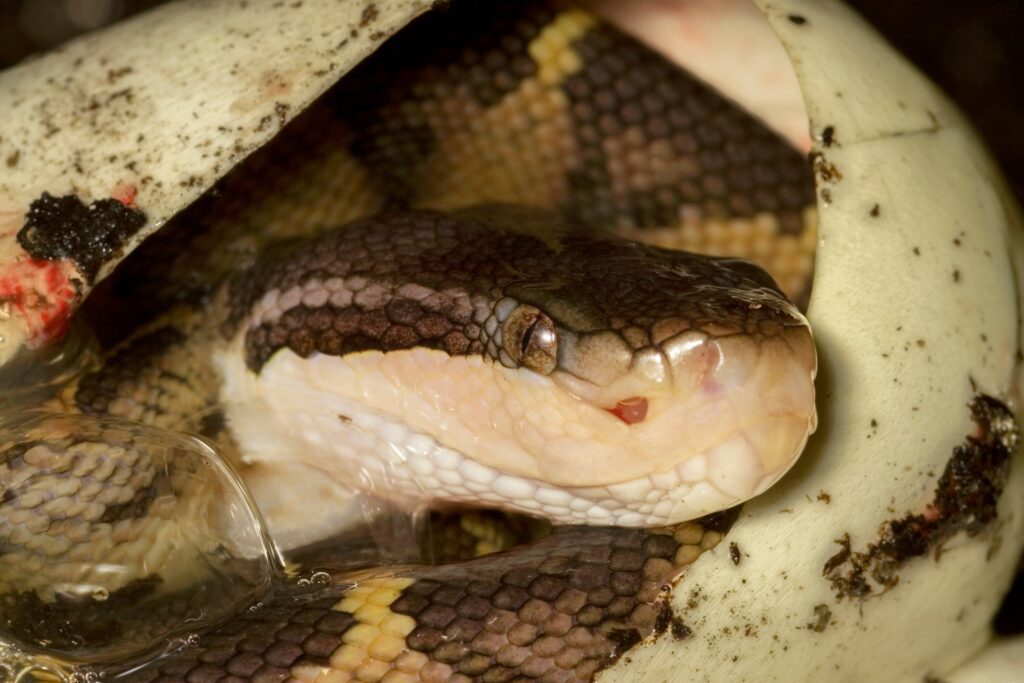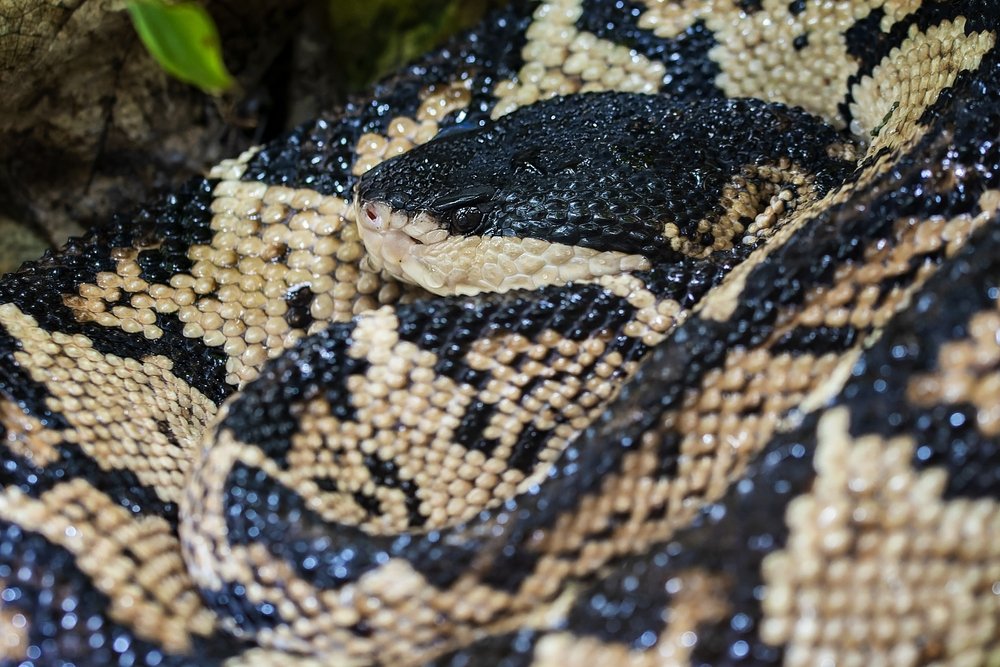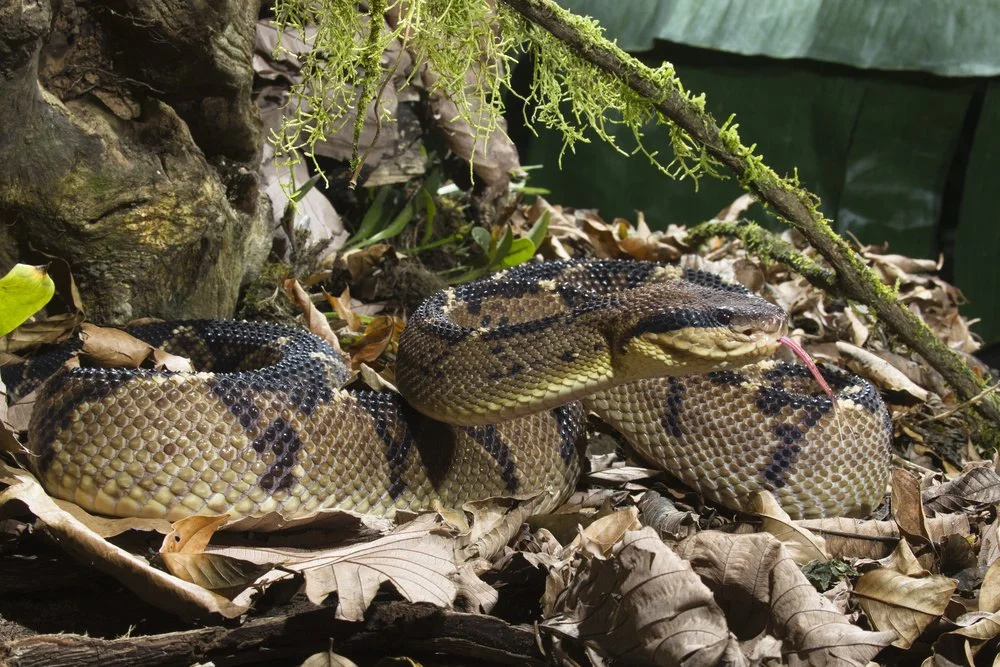Comprised of four distinct species from Central and South America, the Lachesis genus, commonly named ‘bushmasters’ are some of the largest venomous snakes on the planet. Lachesis muta or the South American Bushmaster can reach an enormous 11 feet in length, making it the largest viper in the world. Despite this, they are some of the most secretive of all snakes. As in-situ and ex-situ research embellishes our understanding of these mysterious animals, herpetologists are beginning to learn more than ever about these true rainforest legends.
An introduction to bushmasters
Bushmasters are members of the Crotalinae subfamily – a group shared with rattlesnakes, lanceheads and Asian pit vipers. Like their relatives, bushmasters are ambush predators often waiting several weeks coiled in position, waiting to strike their prey with lethal venom. In fact, researchers in Costa Rica discovered one individual resting in the same location every day for two months.
In the wild, bushmasters will typically prey on rodents and marsupials. There are currently no records of bushmasters feeding on amphibians, birds or reptiles although this may occur. Vipers are well-known for feeding on prey much bigger than themselves, but bushmasters, given their enormous size, will feed on relatively small-bodied prey. They will tend to rest under trees with fruiting bodies, to pick off any small mammals that come to feed on the falling fruit. This does place them in immediate danger of their predators, collared peccaries (Dicotyles tajacu). These small mammals (that look very much like pigs) are known to kill and eat any snake they come across and juvenile bushmasters are no exception.
All bushmasters are considered nocturnal. However, males searching for a mate will become crepuscular as they move around the primary forest in search of a mate. Following pheromones, they are most active around 8 pm and rarely past 11 pm. Being such cryptic animals, little is known about the conservation status of bushmasters. Whilst an individual animal is likely to stay put for several weeks, finding and monitoring the number of new animals is extremely difficult. Even with frequent expeditions and tours to find these animals, few wildlife photographers ever get the chance to see these animals in the wild.
In South America, the Chocoan bushmaster (L. achrochorda) inhabits Southern Panama, stretching across Northern Colombia into the Choco region, as well as Northwestern Ecuador. The South American bushmaster (L. muta) has the largest distribution of all and can be found throughout primary rainforests West of the Andes with the bulk of its range stretching across Northern Brazil. Further North, L. stenophrys (Central American Bushmaster) and L. melanocephola (black-headed bushmaster) can be found throughout Costa Rica, with the former found in the East (and adjacent Panama) and the latter on the West Coast. Researchers are currently pushing to elevate the IUCN Conservation Status of the black-headed bushmaster to ‘Critically Endangered’ as much of its historical range has now been lost to agriculture. Now, this species is only found in the interior depths of the Osa Peninsula. Cesar Barrio Amoros et al write: “Venomous snakes are difficult to protect. Even species known to be rare in the wild or restricted to small ranges are frequently not protected by local, national, or international legislation. Of all Lachesis, only the subspecies L. muta rhombeata is included on the IUCN Red List as Vulnerable. However, that taxon is no longer valid, leaving the isolated Atlantic populations of L. muta totally unprotected in the remaining 7% of the original Atlantic Forest as of 2008. Lachesis melanocephala, with a total range of 4,828.15 km2, is the bushmaster with the smallest distribution and the most threats to its survival.”
“We further suggest that Lachesis stenophrys, L. achrochorda, and L. muta deserve NT (Near Threatened) status due to their scarcity and a multitude of threats, despite all having extensive ranges. However, conditions within nations vary considerably. For example, while L. acrochorda in the Colombian Choco probably deserves an LC (Least Concern), its dramatically reduced distributions in Ecuador and Panama must be reviewed.”
Breeding behaviours
One of the most unique things about bushmasters is their reproductive behaviour. They are the only pit viper in the Americas to lay eggs. Females will coil around their clutch for an incubation period of almost 3 months. From this vulnerable position, she does not feed. Instead, the mother fiercely defends her clutch from would-be predators. Bushmasters are an excellent indicator of a healthy forest. They only occupy the densest inner jungle and therefore, studying the breeding behaviours of this species has been difficult. Historically, in-situ breeding projects led the charge in understanding these secretive snakes. For example, anecdotal observations from facilities in South America have documented that females will lure males in with their sharp, pointed tails. Whether this is a result of pheromones, or a visual cue is yet to be understood.
With in-situ research supporting international breeding projects, bushmasters are now being bred in zoos and our understanding of bushmasters is increasing rapidly. In 2021, ZSL London Zoo was the first UK institution to successfully breed a bushmaster species. Led by Senior Keeper, Daniel Kane, the herpetology department successfully produced five neonate Lachesis stenophrys from an adult pair that they acquired five years prior. Daniel told Exotics Keeper Magazine: “It’s an absolute privilege to work with this species.”
“We put the pair together when they were adults. They had lived separately for all their juvenile years in an off-show enclosure. We put them into the exhibit in March and had a few months to settle them in. Over the UK winter, it was a bit cooler in the exhibit, especially with the spray system. So, they had gone from large off-show custom exhibits that we manually sprayed, into an on-show exhibit with regular, intense misting. The temperature in the exhibit was also much cooler compared to how it was off-show. I think this was the trigger for them. Cooler and much wetter conditions encourage Lachesis to breed. It’s odd really, with a typical snake you would think a cooler, dryer winter and a hotter, wetter summer would be the natural distinctions between the seasons. It’s the opposite with these guys! They like cold and wet, which is a classic for developing respiratory conditions but L. stenophrys has evolved to deal with that.”
Although the pairing went extremely well, there were some things that the team couldn’t prepare for. Daniel continued: “They were paired in March/April and by July, at 6 pm as we were walking out the door, we noticed the female halfway through laying a clutch of eggs. It was too late to do anything about it that day. It was just typical that I was going on holiday the next day and I’m thinking ‘why didn’t this happen a day before!’. We didn’t get to see the courtship as I imagine it happened overnight. It would have been amazing to see that. In the future, we will look to get CCTV cameras inside exhibits to record behaviours like that.”
Keepers at ZSL London Zoo were able to get first-hand experience with the viper’s unusual egg-laying habits. “The eggs are quite large, around 9cm in length which is quite an investment on the female’s part” added Daniel. “The clutch we had represented about 26% of her entire body weight.”
“The rest of the team did a great job of removing the eggs. The females probably would incubate the eggs themselves and guard the clutch against any would-be predators. In the interest of ensuring the eggs come full-term, we intervened, and all five eggs hatched with no issues! Currently, we have three of the five youngsters and the other two have gone to other scientific organisations to help us learn more about the venom.”
Having sourced the bushmaster parents as young juveniles, the keepers had a great understanding of how to maintain the newly hatched juveniles. As a species which is rarely kept, the Zoological Society of London can now accurately study the entire development cycle of the species which has been used to help inform other scientific organisations’ work. One major observation that the team have managed to document is the rate of growth for L. stenophrys. Daniel continued: “We got the original group of youngsters in about six years ago and they grew really quickly! I didn’t know just how quickly they would grow. Within a year they put on around 600-700 grams. We have youngsters upstairs that are about one and a half years old and they’re already 1.2m long.”
Bushmaster husbandry
ZSL have published a ‘best practice’ guide to help inform other organisations on successful husbandry methods. Drawing on research from in-situ studies and supported by the teams’ personal experiences visiting Central America, they have developed a finely tuned exhibit to maintain the animals. Daniel continued: “Many of the books say this species only survives in primary rainforest and that certainly seems to ring true. We have created an exhibit with lots of holes and hiding spaces. They don’t seem to tolerate warm temperatures. Obviously, in Central America we expect it to be warm for a lot of the year. These guys do spend a lot of their time in burrows of armadillos or agoutis which helps moderate the temperatures, keeping them cool and humid. Without that fauna, you lose the structure of the habitat the bushmasters are reliant upon. In secondary forests, you have more Fer-de-lance (Bothrops asper) which can withstand the higher temperatures and live more readily around humans.”
Naturally, creating an enclosure designed for a highly specialised species requires a significant amount of research and planning. In the wild, reptile distribution can be dependent on elevations, microclimates, specific flora and fauna and just about any other variable within an ecosystem. Sometimes these elements can be contradictory and recreating this with limited resources can be a challenge. “We have learnt they need a humid but dry environment” explained Daniel. “That’s extremely difficult as the two do not go hand in hand. Obviously to raise humidity you would usually turn on the misting system and saturate the substrate. But if bushmasters don’t have somewhere dry to rest, over some time you can get a reddening of the ventral scales which is quite well known in Lachesis. To combat this, we’ve got a nice deep layer of leaf litter which will dry out quite quickly. As well as a deep layer of substrate to hold onto the humidity, plus misting systems that go off twice a day. We’ve cracked it now, but that did take a little while to get right.”
Being the world’s oldest scientific zoo, ZSL London Zoo has a whole wealth of resources to ensure the species is kept at optimal conditions. Despite being a potentially very dangerous animal to manage and one which reaches an immense size, the keepers at London Zoo are fully equipped to facilitate appropriate husbandry. “We have two snakes living in the exhibit which is about four meters across and two and a half deep” added Daniel. “It also sits on a hillside, so when it’s quite warm they have the choice of temperature gradient and hiding opportunities. We have humidifiers across the exhibit too, so it’s entirely on them whether they want to be warm, cool, dry or humid.”
“Maintaining a good environment for this species does take a bit of work. They do best kept at around 20-25°C. We have air conditioning, so we can raise and lower the temperature. We also have that off-show, which can be set to a gradual increase. Instead of it hitting 9 AM and bumping straight up to 25C, it’s a slow process that mirrors how it would be in the wild. They have basking lights as well. I’ve read in the past that they don’t require this and that’s not how they thermoregulate. We have a large enough space here to provide them with the option to, which I think is really important.”
In rare cases, when the animals need to be moved or have medical check-ups the team at ZSL use a ‘hands-off’ approach. By using two sets of professional snake hooks, they can keep a lot of distance between the keeper and the animal. The size of the exhibits is also a key component of safety. The keepers can physically enter the exhibit after containing the snakes to undertake any maintenance work. Daniel continued: “When it comes to measuring environmental parameters and changing lightbulbs or measuring UV index etc we must take the animal out of the exhibit. We remove them and place them into a box which we either leave inside the exhibit or take outside of the exhibit. They’re an absolute dream to work with so it’s mostly very straightforward. We also use specialist equipment. For example, your typical snake hook is just one curved piece of metal. With a large heavy-bodied terrestrial snake if you’re only picking them up with one or even two thin hooks it’s putting an awful lot of pressure on particular points on that snake. So, we use very wide hooks to help spread that weight more evenly and make it more comfortable for the snake. Should we need veterinary intervention we also have clear tubes that we can encourage them into to get a closer look.”
“They’re extremely calm natured. We have other species of viper that are more prone to show defensive behaviours when disturbed. Bushmasters, in my experience, tend to sit still and are obliging to work with. This can be disconcerting sometimes as, when they’re fed, they can be accurate with their strike.”
Working with venomous snakes
In the UK, a DWA (Dangerous Wild Animals) licence is required to keep front-fanged venomous snakes. However, local councils can also impose extra restrictions on zoos. For example, City of Westminster Council demands that the site also keeps antivenom available for the kept species. For certain genera such as Crotalus, this very expensive product expires quickly and must be replaced frequently. This has created challenges for even the largest zoos, including ZSL London Zoo. Daniel continued “we now focus our work primarily on EDGE species. These are animals that are “evolutionarily distinct and globally endangered”, and means we can prioritise our conservation efforts to focus on the most unique species on the planet. Although Western diamondback rattlesnakes (Crotalus atrox) are incredibly impressive animals, we had to invest a lot of money in their upkeep and so it made sense for us to exhibit a species which would benefit more from a conservation perspective instead.”
Although DWA-keeping in the private sector is an incredibly niche field, the development of husbandry practices as well as safe-handling methods has had far-reaching implications for medical developments. Keepers that work in an official setting such as zoos or laboratories can contribute venom samples to schools of tropical medicine across the world. In some regions, this is more prominent. For example, Australia Reptile Park has had a snake venom programme since the 1950s and a spider venom programme since 1981. They have been the sole providers of terrestrial snake venom in the country and have since saved an estimated 20,000 lives. The more recent ‘spider venom programme’ sees them house over 2,000 funnel-web spiders to create important new medicines.
Here in the UK, captive-bred venomous snakes can help support international programmes. Collaborative research is helping to save countless lives across the world, especially in less-developed countries. The World Health Organisation estimates that between 81,000 and 137,000 people are killed each year due to snake bites. In Australia, where several of the most venomous species live, just three people are killed by snakes each year (this number is similar in the USA despite several highly dangerous rattlesnake species being present). Therefore, international efforts to produce antivenoms that are accessible globally is extremely important.
In the Central American bushmasters’ native range of Costa Rica, huge strides are being taken to reduce snakebite fatalities. As a country which is perhaps more financially stable than most Central and South American countries, snakebites still pose a threat to both people and animals. At a 2016 WHO conference, Costa Rican officials outlined a plan to cut snakebite mortality rates in half by 2030. With international institutions learning more about the venom of the most dangerous snake species, this goal is much more achievable.
Daniel concluded: “Of the five juveniles that we had, two of them have gone to an organisation in the UK that works primarily with venomous snakes. It’s great that these animals can go on to help others learn more about Lachesis. Perhaps we’ll learn more about the venom which could have any number of pharmaceutical applications in the future.”
Learn more about snakes by signing up to Exotics Keeper Magazine for FREE here
Did you know?
The name Lachesis references the second of the three Greek fates. In Greek mythology, Lachesis decided how much time a person has. This is a clear nod to the potentially lethal bite of the Bushmaster.
The South American bushmaster is the longest pit viper and the second-longest venomous snake in the world, beaten only by the King Cobra (Ophiophagus hannah).
Bushmasters can be found in over a dozen countries but are rarely encountered by humans due to their cryptic behaviours and specific habitat requirements.








